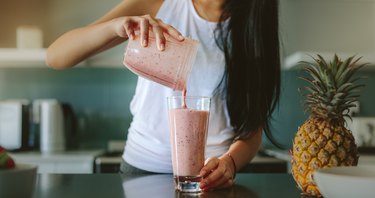
A pancreatitis diet plan might consist of the following: fruits, vegetables, low-fat or nonfat dairy, all of which can be blended and made into a nutritional drink, such as a smoothie. Those with pancreatitis should also make sure to avoid alcohol.
What is Pancreatitis?
Video of the Day
According to Better Health Channel, pancreatitis is when the pancreas is inflamed. Inflammation can either be chronic and long-lasting or acute, lasting only for a short bout. The most common causes of pancreatitis are heavy alcohol consumption and gallstones, followed by viruses, certain medications, trauma or surgery to the pancreas and inherited abnormalities or disorders of the pancreas.
Video of the Day
Symptoms of acute pancreatitis may include bloating, fever, sweating, nausea, vomiting and severe abdominal pain. Those with chronic pancreatitis will likely experience bouts of inflammation, causing foul-smelling feces and severe abdominal pain that is constant. It can also cause weight loss, as the body would have difficulty absorbing food.
Pancreatitis can be diagnosed with a number of methods including blood tests, x-rays, a physical examination, a CT scan, ultrasound and MRI scan. Treatment may vary depending on the level of severity. Treatment may include hospital care, surgery, fasting and intravenous fluids and lifestyle changes, such as regularly consuming nutritional drinks and meals and avoiding alcohol.
Pancreatitis Diet Plan
One way to help treat pancreatitis is with a pancreatitis diet plan. According to Columbia University Irving Medical Center, nutrition plays a vital role in the treatment of pancreatitis. Managing your diet can prevent nutritional deficits, preserve normal blood sugar levels, prevent or manage other conditions associated with pancreatitis, such as diabetes and avoid causing pancreatitis flare-ups.
A protein-rich and nutrient-dense diet that includes fruits, vegetables, whole grains, low fat dairy and other lean protein sources, can help ameliorate your pancreatitis symptoms. Pancreatitis diet recipes and smoothies for pancreatitis should supplement your diet with vitamins that are often lacking in those with pancreatitis, such as vitamin E, vitamin A, Vitamin D, calcium, iron and more.
Antioxidant rich foods — great for adding to nutritional shakes and smoothies — include dark leafy vegetables, red berries, carrots, grapes, blueberries and pomegranates. These are also helpful for those with pancreatitis, says Cleveland Clinic.
As for why consuming fruits and vegetables is beneficial for those with pancreatitis: It increases your fiber intake and limits cholesterol consumption. This lowers the risk of high triglycerides or developing gallstones. Furthermore, antioxidants can also diminish inflammation.
Pancreatitis Food Do's and Don’ts
If pancreatitis was caused by alcohol, then you should refrain from drinking alcohol altogether, explains Columbia University. Even if your pancreas returns to normal, you should still avoid alcohol, and it should only be taken in moderation: one serving a day, maximum. Smoking should also be avoided for those with pancreatitis as it can lead to pancreatic cancer.
The Cleveland Clinic recommends limiting fried or full-fat foods or foods that are high in sugar, such as pastries, sugary drinks, full-fat dairy, french fries, organ meat, butter, margarine, mayonnaise and red meat. These foods can be harmful, as the pancreas processes fat. So the more of it you eat, the harder your pancreas is likely to work.
Staying hydrated and getting the proper vitamin intake are key to preventing or treating pancreatitis. That's why nutritional drinks are so important.
In the National Pancreas Foundation's Chronic Pancreatitis Cookbook, one smoothie recipe calls for one banana, one Granny Smith apple, 1 cup of nonfat plain yogurt, ½ cup water and 1 tablespoon of wheat germ or wheat bran. Blend together and serve. Try this recipe or substitute with other vitamin-rich vegetables and fruits.